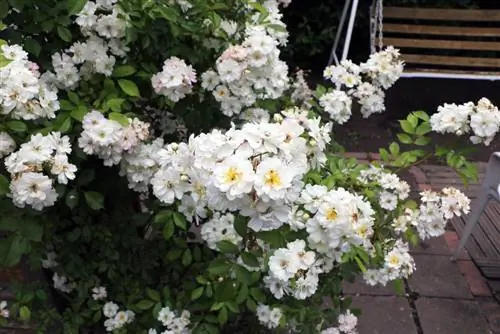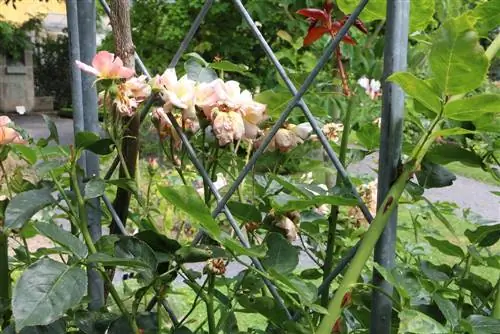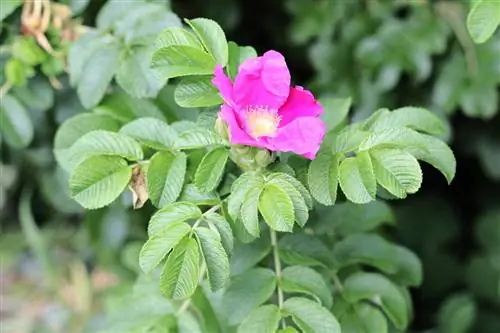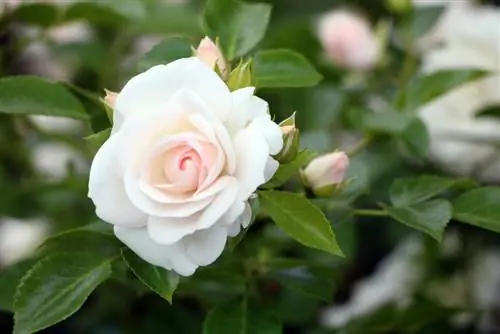- Author admin [email protected].
- Public 2023-12-17 03:39.
- Last modified 2025-01-24 12:45.
Gardens are constantly changing, often in such a way that familiar focal points such as the beautiful old roses suddenly disappear from view or get in the way. Transplanting is then the only sensible thing to do, it just has to be done in such a way that the old rose doesn't suffer. In the article you will learn what you need to consider when transplanting and how to cut the old rose bushes before and after:
The best time to transplant
Roses can be transplanted, just like all other plants, even if they have been in their location for a while. Theoretically, you can transplant roses at any time - as long as the soil is at a temperature at which growth is possible, plant roots can also grow in a new location.
Practically, autumn is the best season for transplanting roses. Then the rose is already in the phase of dormancy or is about to do so, so the upper part of the plant has a break. But the roots continue to grow because the ground is still warm enough. The ground is usually warm enough between October and early December; If you move the rose during this time, it can grow well and in peace until winter until the growth in the upper area starts again next season.
In addition, especially with old roses, you often have to struggle with the difficulty that you can only partially get the roots out of the ground, but many of the fine roots have to be cut off. In this regard, too, you can best help the rose if you choose the autumn time for transplanting; So the rose and its foliage initially have no burden.
Tip:
If you cannot freely choose the time to transplant, you can also transplant the rose in spring or summer. Then you should be prepared for the fact that you have to pay close attention to the rose's adequate water supply. As a result of climate change, some springs surprise with summery temperatures and dryness, heat phases in summer are common; If the rose that has just been transplanted does not receive enough additional water during such times, fine roots that are currently developing will die very quickly.
Preparing for transplanting
If it is unavoidable to transplant a rose that has been growing in one place for years, you must of course first find a new place for this rose. If the rose to be moved occasionally showed certain weaknesses in its old place, you now have the chance to choose the new location so that the rose grows even he althier and stronger:
- Roses that have repeatedly had fungal problems should be given a better ventilated location
- In addition, several hives should be placed a little further apart at the new location
- If you had to repeatedly slow down the rose's desire to grow taller, the new location should allow for more upward growth
- If the rose in the old location threatened to dry out in every small period of heat, the new location should offer slightly better moist soil
- You can also influence the moisture of the soil by improving the structure, but the location definitely plays a role (from the hill to the valley)
If the rose grew optimally, you just need to find a location that is equally suitable for growing roses, the general characteristics of which are as follows:
- As much sun as possible
- But not the intense heat that inadequately ventilated, south-facing locations can develop
- Roses usually like a location that faces southwest or southeast
- But the air circulation also has to be right in these locations
- It is best to plant the roses so that they are often exposed to moderate drafts
- This also applies to the space from one rose to the next, it is better to place a rose bush somewhere else than to place the roses too close together
- Only if the leaves of the roses can dry quickly after rain can the plants permanently resist fungi and other pests
- The roses can still like locations with less light, but in an otherwise quite friendly and warm microclimate
- At the new location, the soil is loosened well before transplanting
- Depending on previous use, the soil must be freed of nutrients or enriched with nutrients
- If well-fertilized, heavily consuming vegetables previously grew in this area, a little coarse sand usually needs to be mixed in
- If it was more like steppe there, a good load of ripe compost is mixed into the soil (preferably some time before turning)
- Immediately before transplanting, the soil may receive some liquid fertilizer, e.g. B. fertilizing plant manure
Preparing roses for transplanting

The rose must be cut back heavily before transplanting. Even if it hurts your heart to radically cut away long, well-developed shoots, attempts to save any of the rose's shoots usually come at the expense of the rose. Because it will certainly be lightened by a few fine roots during the transplanting and has enough to do with allowing the part underground to grow back to such an extent that the supply is good again. During this phase of limited performance, the plant is unable to adequately supply shoots and leaves for several weeks.
Therefore, the entire above-ground part of the rose is cut back vigorously as soon as the rose has lost its leaves; more than around 40 cm should not remain. This doesn't bother roses, they always sprout, even from old wood. As with the choice of location, the following also applies here: take advantage of the opportunity to improve old weak points - at this stage it doesn't matter much to the rose if the crooked base shoot is cut down a little further.
Dig up roses at the old location
When you dig up the rose, it would be good if you knew what kind of rose it is. This influences how deep you have to dig:
- The roots of grafted roses usually grow straight downwards
- For an old rose, also very deep into the soil
- Here you have to dig close to the rootstock, but possibly quite deep
- Digging up is usually not a problem for adult roses that have been in the location for a long time but are only a few years old
- Ground the rose and push the spade one to two blade lengths deep into the soil from all sides
- Loosen each time by moving the spade handle when the spade blade is at its lowest point
- If the root has been circled in this way, the rhizome can usually be levered out of the ground without any problems
- If the roots reach deeper than two spades into the ground, a trench is first dug around the rose
- So you get a little deeper and from here carry out the cookie-cutting action just described
- If the root cannot be dug out to the last tip, it doesn't make much difference to he althy roses
- The root is cut cleanly at the reachable depth and grows back in the new location
- Historical roses grow differently and stand on their own roots
- These true-root roses also grow runners underground
- This is simply about taking as many roots with you to the new location as possible
Tip:
If it really is an ancient rose, the age of which you may not be able to tell at all because it was already there when you took over the garden, some caution is advised. If this rose has been in the garden for significantly longer than the four or five years in which transplanting is usually not a problem, moving it is only advisable if the rose is visibly strong and he althy. You then don't know whether and how the roots have spread underground, but you have to try to get as many roots as possible out of the earth undamaged. If this is successful, even the oldest roses can grow again; If, while digging, you notice that the rootstock could only be excavated undamaged with an excavator, things could become critical. Here you should therefore take better precautions and propagate the rose from cuttings before transplanting.
Pruning roots
Once you have dug up the root, it will be inspected closely. Any root that was injured during digging is trimmed by the injured piece because only a clean cut heals quickly and opens the way for new growth. You can also use the opportunity to remove any malformed, strangely growing, possibly nibbled roots, etc. from the rose. Overall, the more roots remain intact when transplanting, the easier the rose will grow.
If for some reason you were only able to dig up or keep a small part of the rootstock, the scissors must also be applied to the above-ground part again - the plant mass in the upper part can only be looked after until it grows again if it is in the is taken back in the same ratio as the root.
Dig and prepare planting hole

Once you have “lightened” the rose at the top and dug it up, the planting hole can be dug at the new location. You now know how deep you have to dig; If the soil prepared on the surface turns out to be rather poor at the depth required, a bag of good rose soil offers the quickest solution: add it to the bottom of the planting hole before planting the rose.
Even if you have dug up a powerful root and are now at the limit of your strength: Please dig the planting hole so deep and wide that the rhizome fits comfortably in it. Every kinked root not only delays growth, but is also a disease A welcome gateway for fungi, bacteria and viruses.
Planting a rose
When the rose is placed in the prepared planting hole, it is important to ensure that the grafting point is a few (3-5) centimeters below the natural soil horizon. This grafting point can be recognized by the fact that the root collar is slightly thickened at this point.
If the rose sits well and stands straight (using a spirit level is not a mistake here - if a slight tilt is only noticeable from a distance, you'll be annoyed forever and it won't do the rose any good either), you can the planting hole must be filled with the excavated material. The excavation should be well pressed all around, and the soil in the planting hole may also need to be topped up to surface level when piling up.
Pouring and piling
What the newly planted rose needs most now is water, all around it, because the roots do not yet have good contact with the soil and otherwise they will dry out in a very short time. For a normal-sized rootstock, a good 10 liters of water is enough to slurry it up, which can still be done with a watering can. This can look completely different with the larger rhizomes of older or unrooted roses, but here too you should switch the watering can between the garden hose and the rose so that you can keep track of the quantities. The water is only of use to the roots if they also get oxygen.
In warm weather, the hose and watering can should continue to be used for the next two weeks, as it may take until the rose roots have full contact with the ground again. Hilling up the newly planted rose serves exactly this purpose; the small mound of soil around the remaining shoots of the rose (of which no more than the tips need to be visible when transplanted in the fall) initially holds a lot more moisture in the soil. In addition, for roses that were transplanted in the fall, this mound of soil remains on the rose until the next spring as winter protection. Most of the time you don't have to do anything with the piled up soil because the pile will be leveled by the rain over time.
After the first two weeks, the rose can basically be watered as before it was moved, but you should initially remain careful: it may develop a completely different thirst in the new location than in the old one.
On roses transplanted in autumn, you won't see that everything went well until next spring; A rose transplanted in spring should grow fresh green again over the course of the summer, and the first buds will often appear again by autumn. However, if a rose needs a little longer, you should give it this time and trust in its strength.






